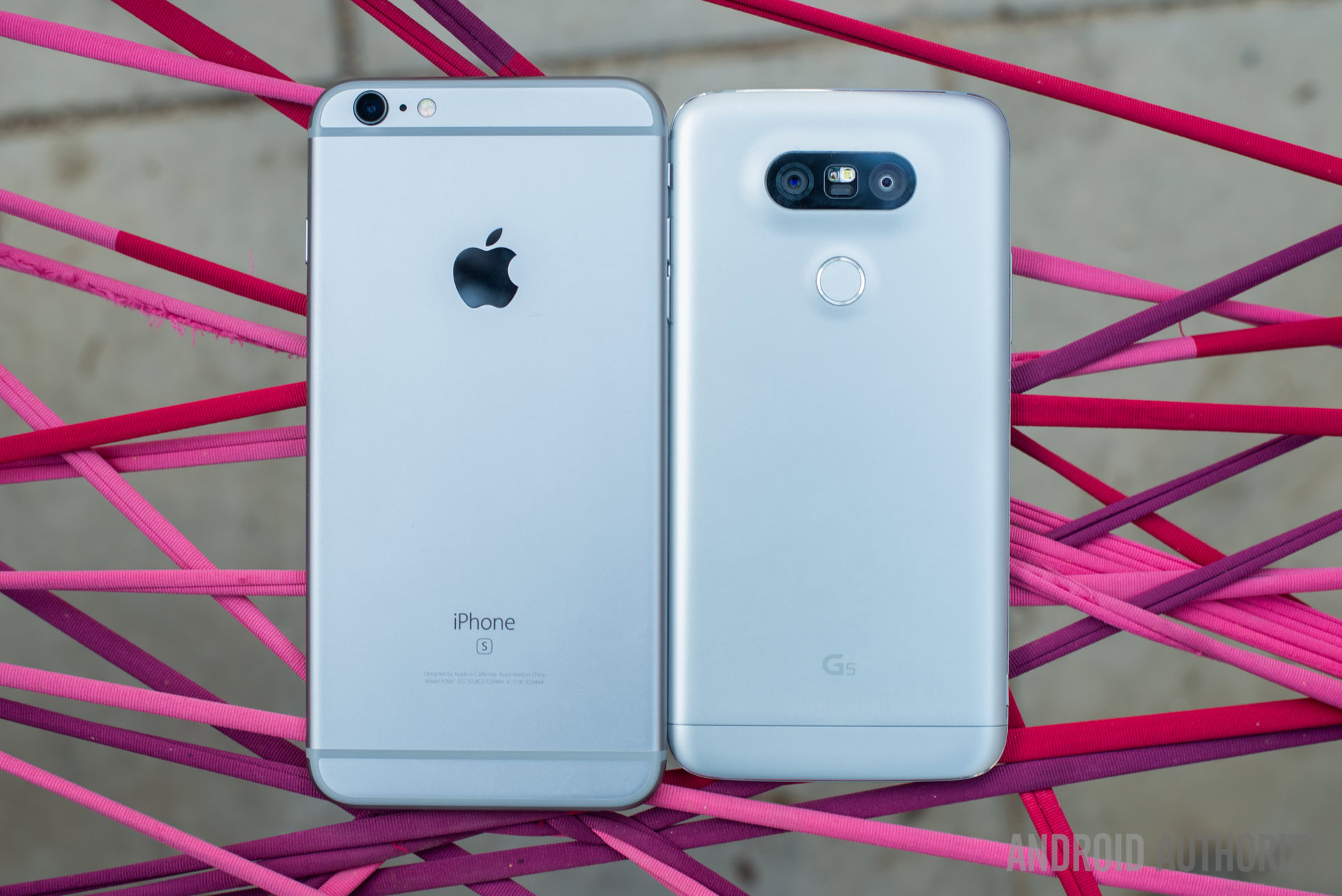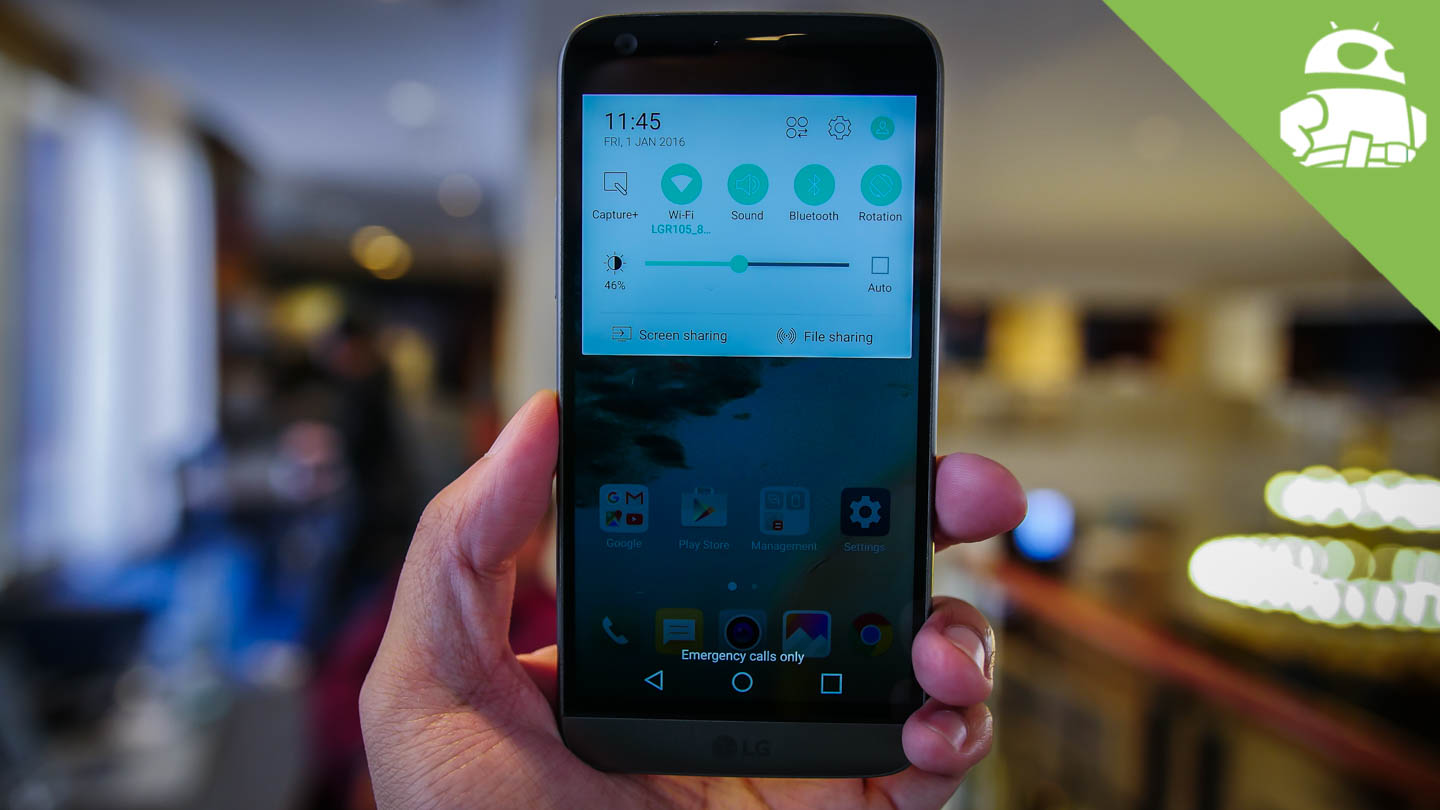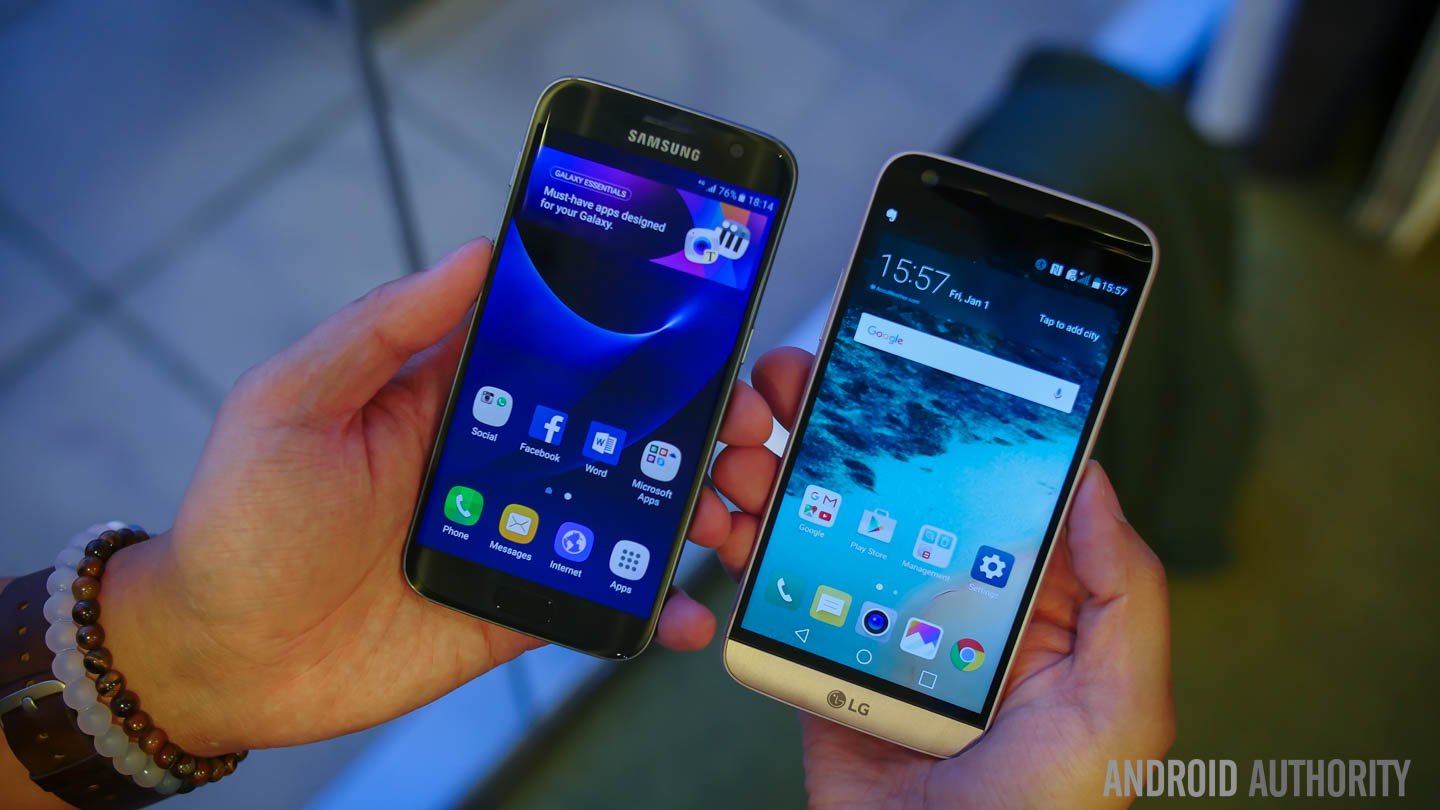Affiliate links on Android Authority may earn us a commission. Learn more.
LG G5 vs Apple iPhone 6s Plus comparison
February 23, 2016

During MWC 2016 we had the opportunity to spend a lengthy period of time with the LG G5, getting a better look at LG’s dramatic revisioning of the G series. We’ve already pitted the phone against some of the biggest names in the Android world, including Samsung, but we can’t forget about the other king of mobile.
So how does the LG G5 compare to Apple’s current-gen iPhone? We find out in this written comparison of the LG G5 vs iPhone 6s Plus!
[related_videos align=”center” type=”custom” videos=”674985,675002,674813,674817″]
Design
While the Apple iPhone 6s Plus sees few visible changes when compared to the iPhone 6 family, the LG G5 embraces a totally new direction for LG, complete with its first metal unibody design. This design takes a unique twist in the form of a removable ‘cap’ that houses the removable battery and allows for the addition of special modular accessories.
It’s not just the build materials that LG changed either. The G5 does away with the iconic rear volume rockers, moving them to the left side instead. The power button does stay on the back, however, this time with an integrated fingerprint scanner similar to what was offered on the LG V10. Thanks to a smaller display, the LG G5 should be a bit more one-hand friendly than the LG G4, even if not by much.
The G5 does away with the iconic rear volume rockers, moving them to the left side instead.
On the other hand, Apple continues its tradition of keeping design changes to a minimum with its “s” releases, and so the iPhone 6s Plus certainly feels very familiar when compared to its own predecessor. Of course the design isn’t completely the same, with the latest iteration receiving a build quality upgrade, thanks to the use of stronger 7000 series aluminum, a change likely meant to prevent another “bendgate” from occurring. Stronger metal also translates a slightly thicker, wider, taller, and heavier phone than the iPhone 6 Plus, though only noticeable to the most keen of eyes.
When it comes to design, personal preferences will certainly vary wildly. Personally, I find both designs to be a tad bit “boring”, though I’m sure I am in the minority there, especially when it comes to the iPhone. Ultimately, certain touches like a rear-mounted fingerprint scanner speak to me a bit more than the iPhone’s design does, though I wish the camera hump on the G5 was different. Of course you’re own opinion will likely differ from mine, but that’s the beauty of having choices in the mobile world.
Display
If design differences weren’t dramatic enough for you, things continue to diverge significantly when it comes to display.
While the LG G5 offers a larger 5.3-inch QHD (1440 x 2560) display, the iPhone 6s Plus features a 5.5-inch display with a more modest 1080p resolution. Both screens are of the LCD variety, however. While the iPhone’s display does a pretty solid job, those looking for the best display experience possible will obviously be drawn to the LG G5 over the iPhone 6s Plus. Reading text, watching movies, and playing games will all have the extra bit of clarity to it.
The G5 also has the distinction of offering an always-on display, which means that you can always see the time and other key pieces of information at a glance, all without taking a significant hit to the phone’s battery life. This isn’t something offered on the iPhone 6s Pluls, though perhaps a future model?
Performance and hardware
The LG G5 is powered by a quad-core Qualcomm Snapdragon 820, backed by an Adreno 530 GPU with 4GB RAM. In contrast, the iPhone 6s Pluls features a dual-core Apple A9 processor, clocked at 1.84 GHz, and backed by the PowerVR GT7600 GPU with 2 GB RAM.
If you were to judge things by how they sound on paper, the iPhone 6s Plus would certainly seem underpowered, but keep in mind we are talking about two very different ecosystems, and thanks to a very optimized OS/hardware relationship with Apple’s products, it takes a lot less technical omph to make the iPhone play nicely.
If you were to judge things by how they sound on paper, the iPhone 6s Plus would certainly seem underpowered, but keep in mind we are talking about two very different ecosystems
When it comes to real world performance, the iPhone 6s Plus has already proven itself more than capable of providing a solid mobile experience, and though there have been some minor instances of lag and stutter, overall the experience is very smooth. This is equally true when it comes to gaming. As for the LG G5, it’s hard to give a full impression of the performance situation so early into the game, but so far we like what we’ve seen and have really ran into no lag or stutter in the UI, or when testing out various apps.
[related_videos align=”center” type=”custom” videos=”657282,654055,649187,647458″]
Both phones utilize fast, accurate fingerprint scanners, though the iPhone’s approach places it into the front home button, while the LG G5 uses a rear mounted scanner. As the owner of a Nexus 6P and HUAWEI Mate 8, I personally have come to love the rear scanner implementation and prefer it over the front, but really the experience here should be very similar, positioning aside.
Turning to battery life, the LG G5 shrinks down from a 3000 mAh battery with the G4 to a 2800 mAh battery, compared to the slightly smaller 2750 mAh battery in the iPhone 6s Plus. While battery size is about the same, the LG G5’s unique design allows you to remove it, thus making it possible to swap it out for a fully charged battery. The LG G5 also has the iPhone beat in terms of charging, with Quick Charging 3.0 making it possible to juice up the phone significantly faster.
As as far as other hardware is concerned, the LG G5 has a microSD slot for memory expansion, as well as a new module slot that allows you to expand the phone’s functionality. Two examples of modules that can enhance the G5 experience include a Hi-Fi audio DAC that can be put at the bottom to enhance the audio experience, as well as a camera module, called CAM Plus, which adds hardware buttons, like a shutter button, video record button, zoom scroll, and more, while also adding an additional 1,200 mAh to the battery.
The iPhone doesn’t have microSD or modules, but it does have one unique feature that sets it apart, 3D Touch. Basically there is a pressure-sensitive layer below the display which lets you press a bit harder to open up hidden menus. This helps keep the menus and homescreens looking clean, while adding a lot of functionality, such as Peak and Pop, which allows for a preview of something like an email or an image, and using a little more force will then take you into the full image.
Camera
For years, Apple has been praised for its camera experience, but in 2015 the Android world raised the photo-taking bar significantly. The iPhone 6s Plus responded by upping its camera from an 8MP rear cam to 12MP with a f/ 2.2 aperture and a 5MP front-facer. The end result was a great camera experience that offered a comparable level of quality to what we saw from Android’s best 2015 flagships.
LG also received a fair share of praise for the camera found on it LG G4 and V10 flagships from 2015, and we expect equally great things from the LG G5.
Unfortunately, it’s too early to say if the LG G5’s camera is better than last years, though they have made some interesting changes. In addition to a 16MP standard lense, the main shooter also adds an 8MP wide angle lens to the mix. Having a wider field of view is certainly good to have, and the good news is that it is a fairly seamless experience when making the switch between the two rear cameras. On the front, you’ll find an 8MP shooter.
It goes without saying that we can’t tell you which is better at this stage, but based on a snapshot judgement, we can say that either camera should provide a wonderful experience.
Software
Typically speaking, there are some pretty massive differences when comparing Android phones with iPhones, due to the fact we are talking about two different platforms and ecosystems. This rings true for the LG G5 and iPhone 6s Plus, though there are more similarities here than you might expect. What do we mean by that? Well, for starters, both the iPhone and the LG G5 are lacking something you’ll find on many typical Android devices, an app drawer.

In a somewhat controversial move, LG has ditched the app drawer in favor of an experience where all your apps reside on the homescreen, with folders being utilized for better organization. Of course you can always use a 3rd party launcher to bring back the app drawer, an option you don’t have with iOS. Aside from the lack of an app drawer though, the differences between the two platforms remain, with LG’s UI based on Android 6.0 Marshmallow, which has been streamlined significantly compared to the LG G4, with much of the bloat and added features (such as Q Slides and multi-window) getting the ax.
The iPhone 6s Plus, on the other hand, has seen very little changed in iOS when compared to its predecessor. The home screens remain grid of icons, with the only way to keep things somewhat free from getting too cluttered being folders, and no option to add a launcher that supports an app drawer.
both the iPhone and the LG G5 are lacking something you’ll find on many typical Android devices, an app drawer
There have been a few additions over the last couple of years that have made a difference, such as the notification dropdown, with a secondary screen can bring up a few extra shortcuts and glances at some contextual information, and a swipe up from the bottom opens the Control Center, where a number of controls and toggles are easily accessible. There’s also the previously mentioned 3D touch capabilities.
Except for the similarity that comes from a missing app drawer, these two ecosystems remain very distinct, with the LG G5 utilizing the Google Play store and other Google apps, with the iPhone relying on the App Store. Which is better? The answer to that depends on what you’re looking for in an OS. LG has simplified its UI with the intention of making it easier for those who are looking for something that “just works” out of the box, similar to the iPhone, but what remains different is that Android is still a customizable beast underneath, for those who dare to dig a bit deeper.
Wrap Up
That about wraps things up for this quick comparison between the LG G5 and iPhone 6s Plus. In the hardware front, these two phones have very little in common, aside from the usage of metal. As for software? Things might look a bit similar on the surface, but deep down, these are two very different animals. For those who love the power afforded by Android, the LG G5 is the clear choice. The same goes for those that are lured in by the idea of modular expansion and removable batteries.

If you are looking for something that just works without the bells and whistles, LG claims that the LG G5 can fit the bill here, though this is territory that is typically associated with the iPhone. At the end of the day, the LG G5 probably won’t do much to convert those who are already set on buying an iPhone, or vice versa. As always, different strokes for different folks.
What do you think? Share your thoughts in the comments, and be sure to check out our other great MWC 2016 content.